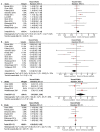Stroke Prophylaxis in Patients with Atrial Fibrillation and End-Stage Renal Disease
- PMID: 31906546
- PMCID: PMC7019832
- DOI: 10.3390/jcm9010123
Stroke Prophylaxis in Patients with Atrial Fibrillation and End-Stage Renal Disease
Abstract
Atrial fibrillation (AF) is an important comorbidity in patients with end-stage renal disease (ESRD) undergoing dialysis that portends increased health care utilization, morbidity, and mortality in this already high-risk population. Patients with ESRD have a particularly high stroke risk, which is further compounded by AF. However, the role of anticoagulation for stroke prophylaxis in ESRD and AF is debated. The ESRD population presents a unique challenge because of the combination of elevated stroke and bleeding risks. Warfarin has been traditionally used in this population, but it is associated with significant risks of minor and major bleeding, particularly intracranial, thus leading many clinicians to forgo anticoagulation altogether. When anticoagulation is prescribed, rates of adherence and persistence are poor, leaving many patients untreated. The direct oral anticoagulants (DOACs) may offer an alternative to warfarin in ESRD patients, but these agents have not been extensively studied in this population and uncertainties regarding comparative effectiveness (versus warfarin, each other, and no treatment) remain. In this review, we discuss the current evidence on the risk and benefits of anticoagulants in this challenging population and comparisons between warfarin and DOACs, and review future directions including options for non-pharmacologic stroke prevention.
Keywords: anticoagulation; atrial fibrillation; end-stage renal disease; stroke prevention.
Conflict of interest statement
The authors declare no conflict of interest.
Figures

Similar articles
-
Periprocedural Outcomes of Direct Oral Anticoagulants Versus Warfarin in Nonvalvular Atrial Fibrillation.Circulation. 2018 Oct 2;138(14):1402-1411. doi: 10.1161/CIRCULATIONAHA.117.031457. Circulation. 2018. PMID: 29794081
-
Direct Oral Anticoagulants vs. Warfarin in Hemodialysis Patients With Atrial Fibrillation: A Systematic Review and Meta-Analysis.Front Cardiovasc Med. 2022 Jun 9;9:847286. doi: 10.3389/fcvm.2022.847286. eCollection 2022. Front Cardiovasc Med. 2022. PMID: 35757350 Free PMC article.
-
Prescription Patterns and Outcomes of Patients With Atrial Fibrillation Treated With Direct Oral Anticoagulants and Warfarin: A Real-World Analysis.J Cardiovasc Pharmacol Ther. 2019 Sep;24(5):428-434. doi: 10.1177/1074248419841634. Epub 2019 Apr 29. J Cardiovasc Pharmacol Ther. 2019. PMID: 31035795
-
Temporal Trends in the Use and Comparative Effectiveness of Direct Oral Anticoagulant Agents Versus Warfarin for Nonvalvular Atrial Fibrillation: A Canadian Population-Based Study.J Am Heart Assoc. 2017 Oct 28;6(11):e007129. doi: 10.1161/JAHA.117.007129. J Am Heart Assoc. 2017. PMID: 29080863 Free PMC article.
-
Anticoagulants in patients with atrial fibrillation and end-stage renal disease.Postgrad Med. 2012 Nov;124(6):17-25. doi: 10.3810/pgm.2012.11.2609. Postgrad Med. 2012. PMID: 23322135 Review.
Cited by
-
Use of non-vitamin K antagonists oral anticoagulants in atrial fibrillation patients on dialysis.Front Cardiovasc Med. 2022 Sep 13;9:1005742. doi: 10.3389/fcvm.2022.1005742. eCollection 2022. Front Cardiovasc Med. 2022. PMID: 36176998 Free PMC article.
-
Expert Opinion on the Use of Novel Oral Anticoagulants for Stroke Prevention in Non-valvular Atrial Fibrillation for the Primary Care Setting in India: A Literature Review.Cureus. 2022 May 18;14(5):e25102. doi: 10.7759/cureus.25102. eCollection 2022 May. Cureus. 2022. PMID: 35733454 Free PMC article. Review.
-
Application of rivaroxaban in patients with non-valvular atrial fibrillation and end-stage kidney disease: A systematic review and meta-analysis.Front Cardiovasc Med. 2023 Feb 7;10:1021959. doi: 10.3389/fcvm.2023.1021959. eCollection 2023. Front Cardiovasc Med. 2023. PMID: 36844734 Free PMC article.
-
The safety and efficacy of direct oral anticoagulants among chronic kidney disease patients on dialysis with non-valvular atrial fibrillation: a meta-analysis.Front Cardiovasc Med. 2023 Sep 18;10:1261183. doi: 10.3389/fcvm.2023.1261183. eCollection 2023. Front Cardiovasc Med. 2023. PMID: 37795477 Free PMC article. Review.
-
Comparative analysis of ischemic and hemorrhagic stroke hospitalization rates in end-stage kidney disease and kidney transplant patients with and without atrial fibrillation.PLoS One. 2024 Dec 16;19(12):e0310181. doi: 10.1371/journal.pone.0310181. eCollection 2024. PLoS One. 2024. PMID: 39680586 Free PMC article.
References
-
- Genovesi S., Pogliani D., Faini A., Valsecchi M.G., Riva A., Stefani F., Acquistapace I., Stella A., Bonforte G., DeVecchi A., et al. Prevalence of atrial fibrillation and associated factors in a population of long-term hemodialysis patients. Am. J. Kidney Dis. 2005;46:897–902. doi: 10.1053/j.ajkd.2005.07.044. - DOI - PubMed
-
- Fabbian F., Catalano C., Lambertini D., Tarroni G., Bordin V., Squerzanti R., Gilli P., Di Landro D., Cavagna R. Clinical characteristics associated to atrial fibrillation in chronic hemodialysis patients. Clin. Nephrol. 2000;54:234–239. - PubMed
Publication types
LinkOut - more resources
Full Text Sources

